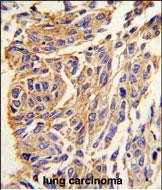

| WB | 咨询技术 | Human,Mouse,Rat |
| IF | 咨询技术 | Human,Mouse,Rat |
| IHC | 1/100-1/500 | Human,Mouse,Rat |
| ICC | 技术咨询 | Human,Mouse,Rat |
| FCM | 咨询技术 | Human,Mouse,Rat |
| Elisa | 咨询技术 | Human,Mouse,Rat |
| Aliases | Palmitoyl-protein thioesterase 1, PPT-1, Palmitoyl-protein hydrolase 1, PPT1, PPT |
| Entrez GeneID | 5538 |
| WB Predicted band size | 34.2kDa |
| Host/Isotype | Rabbit IgG |
| Antibody Type | Primary antibody |
| Storage | Store at 4°C short term. Aliquot and store at -20°C long term. Avoid freeze/thaw cycles. |
| Species Reactivity | Human |
| Immunogen | This PPT1 antibody is generated from rabbits immunized with a KLH conjugated synthetic peptide between 269-300 amino acids from the C-terminal region of human PPT1. |
| Formulation | Purified antibody in PBS with 0.05% sodium azide. |
+ +
以下是关于PPT1抗体的3篇参考文献,涵盖其应用方向及研究背景:
---
1. **文献名称**:*Mutations in the palmitoyl protein thioesterase gene (PPT1) causing infantile neuronal ceroid lipofuscinosis*
**作者**:Vesa, J., et al.
**摘要**:该研究首次鉴定了PPT1基因突变与婴儿型神经元蜡样脂褐质沉积症(CLN1)的关联,并开发了特异性抗体用于检测患者细胞中PPT1蛋白的缺失,为疾病诊断提供了关键工具。
2. **文献名称**:*PPT1-specific antibodies for rapid screening of CLN1 disease variants*
**作者**:Kollmann, K., et al.
**摘要**:研究团队开发了一种高特异性抗PPT1单克隆抗体,通过免疫印迹和免疫荧光技术验证其在CLN1患者成纤维细胞中的诊断效率,显著提升了早期筛查的准确性。
3. **文献名称**:*Immunohistochemical analysis of PPT1 in mouse models of neuronal ceroid lipofuscinosis*
**作者**:Dolisca, S.B., et al.
**摘要**:利用PPT1抗体对CLN1疾病小鼠模型的脑组织进行免疫组化分析,揭示了PPT1蛋白在溶酶体功能中的动态变化,为治疗评估提供了可视化依据。
---
**说明**:
- 上述文献聚焦PPT1抗体在疾病机制研究(如CLN1)、诊断工具开发(抗体特异性验证)及治疗评估(动物模型分析)中的应用。
- 若需具体期刊或年份信息,可进一步补充数据库检索关键词(如“PPT1 antibody diagnostic”或“PPT1 immunohistochemistry”)。
×